I LOVE Halloween. How could I not? It’s a holiday all about dressing up!
I love going all out with Halloween costumes, but I equally love taking ‘everyday’ clothes and sewing patterns and turning them into a costume. There is something really fun and clever about turning a simple thing into something wacky and fabulous with a bit of creativity (remember my circular cardigan Jedi?)
In celebration of this concept, we’ve been brainstorming all sorts of fun costumes you could make from Scroop Patterns.
The Miramar Dress, Top & Tunic
We had to restrain ourself with ideas of costumes that could be made with the Miramar as a base. There are SO many.
Make it floor length in black, add a hat and a broom, and you’re a witch!
Or, a dangling girdle belt, and you’re a medieval maiden.
Many stretch velvets have the right amount of stretch for the Miramar too. Dark red stretch velvet? You’re Mother Gothel! Pale turquoise with a chiffon cape? Elsa! Dark blue? Arwen!
But you don’t have to go full length with the Miramar to have a cool costume. The Curvy Sewing Collective suggested it would be a good base as a Catwoman costume, and we thought the idea was so fun we had an impromptu Catwoman photoshoot.
This really is as impromptu as you can get! I pulled out a black Miramar top, leggings from my favourite legging pattern, cut a quick pair of ears out of some black fabric, stiffened them with interfacing and cellotaped them to a black mask, and we used watercolours to paint my face because I didn’t have any suitable facepaint. Five minute costume for the win!
The cut-on sleeves of the Miramar give it a very 1950s-60s flair which is just so perfect for Catwoman.
The Henrietta Maria Dress & Top
What can you do with the Henrietta Maria?
I got a bunch of suggestions of a Dorothy blouse, with a blue gingham pinafore dress over it, and what do you know, Ciara has already done a delightful Dorothy-esque outfit with the Henrietta Maria over on the Monthly Stitch!
In white, the HM would also be a great pirate shirt – those big puffy sleeves! Arrrrrr matey! (which reminds me how much I want to sew a white HM for myself).
Or, what about a full length Henrietta Maria, in white jersey, with the bottom of the sleeves left loose, as a Princess Leia?
The Fantail Skirt
The Fantail is an obvious choice for all sorts of 1900s-esque costumes: add red hair and you’re Anne of Green Gables; a white blouse, daisy trimmed hat, and red bow tie, and you’re Mary Poppins.
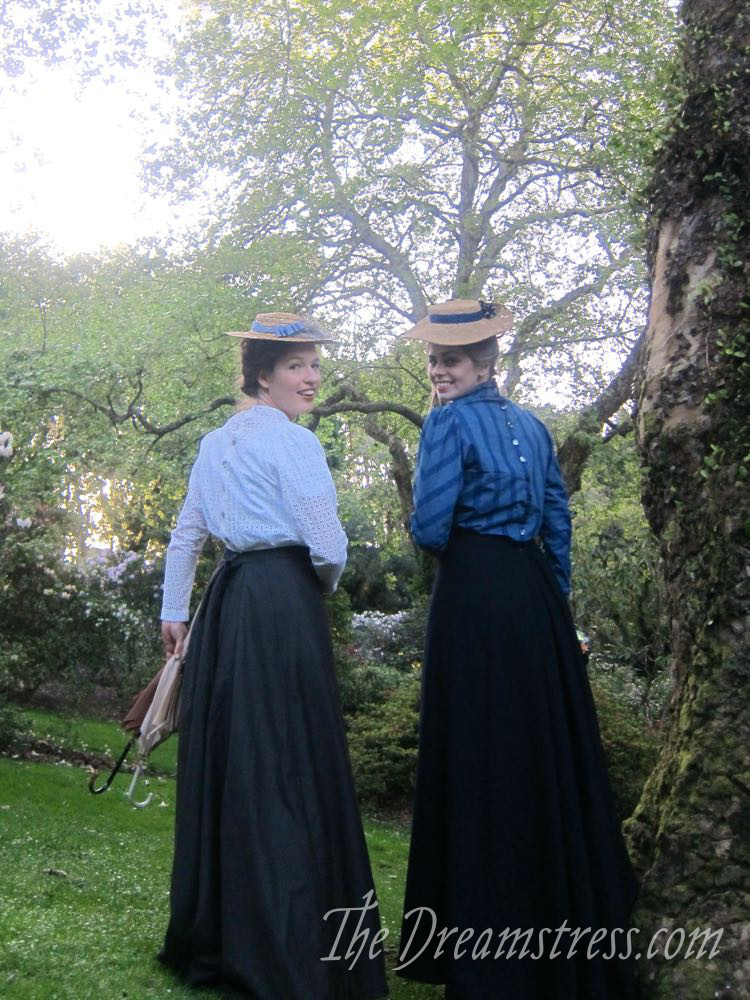 We got a little over-excited brainstorming Fantail ideas, and started debating dividing the back panels into multiple panels, to make a rainbow, with each pleat in a different shade. It would be amazing to see if you tried it!
We got a little over-excited brainstorming Fantail ideas, and started debating dividing the back panels into multiple panels, to make a rainbow, with each pleat in a different shade. It would be amazing to see if you tried it!
The Rilla Corset
You know what I would REALLY love to see someone do with the Rilla? I’d LOVE to see a 1910s period-accurate Wonderwoman corset. Something with a red chemise and blue drawers, and gold binding and trim… I think it’s do-able, and would be amazing! Whose game?
I’m sure there are lots more costumes that could be made from Scroop Patterns! What else can you think of?
Whatever you’re doing for Halloween, happy costuming!


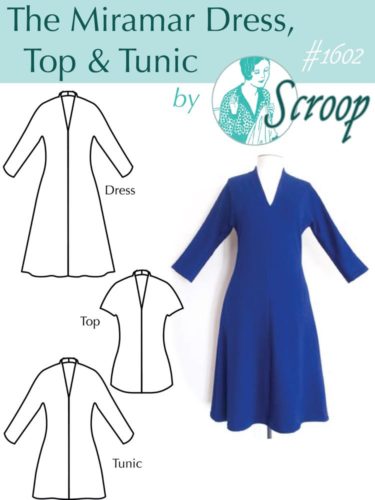

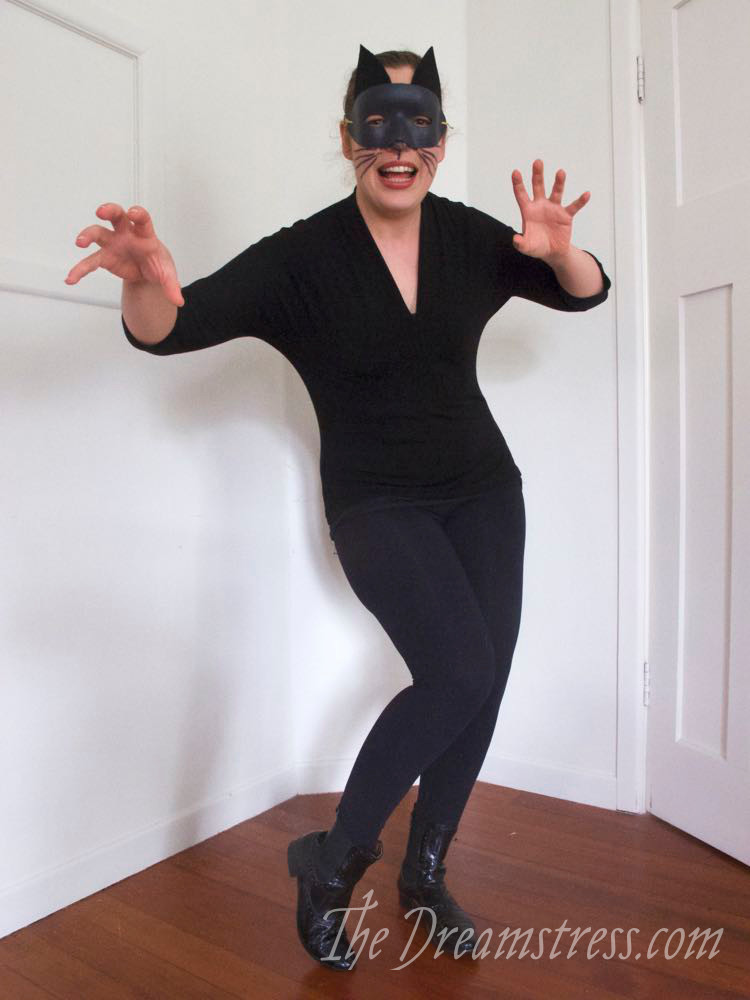
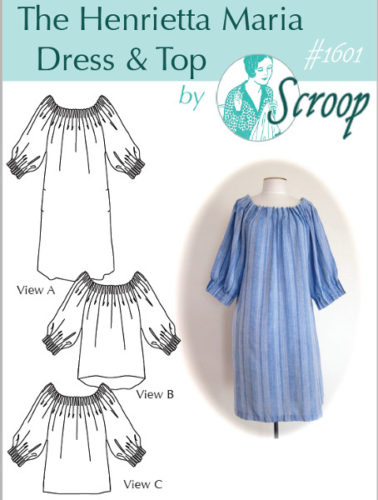

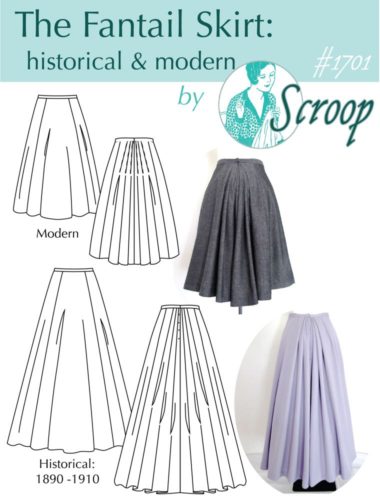
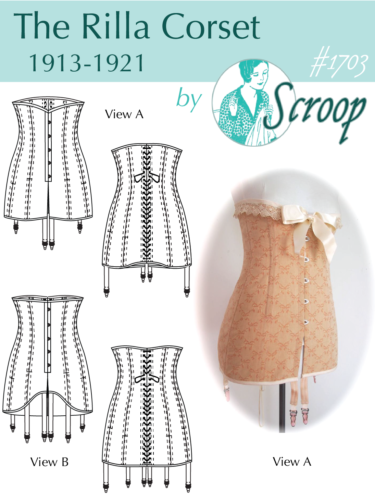
Hehe, so that was what the whiskers were for!
I’m doing nothing for Halloween (one of the foreign holidays I’m happily not borrowing; originally, our dressing-up period would have been before Lent, which I rather like because February is dreary, but it’s sadly not something that seems to be surviving). But there’s going to be another Austen ball on Nov. 4, so I’m definitely doing something… although in my case, it’s probably just accessories to go with what I already have.
(BTW, have you done anything Scroop-worthy in the long Regency era? I think not…)
Also, seeing as the Ngaio is 1930s-inspired, obviously one could do something with that… Ngaio Marsh / Agatha Christie murder victim? 😉
Springtime festivals are wonderful, aren’t they? I remember carnival before Lent in France and Spain. And the Jewish holiday of Purim! Anyhow, any excuse to dress up–especially see adorable kids dress up–is ok by me!
February is more like “that annoying seemingly endless tail end of winter” around here. 😉
Ok, totally true. But February also starts the very beginning of hope: the ice sometimes turns into slush. The bare trees start to show little buds. The whole thing will eventually wake up…if you survive that long! (winking back)
A top-length Henriette Marie would be a good gypsy top. Embroidery below the pleats would make it more gypsy-like, but may not be necessary.
I think gypsy costumes are one of those dress up ideas that’s best left in the past, given the implications of cultural appropriation, and the historic, and continued (in some countries) repression of gypsies and usage of ‘gypsy’ as a slur. 🙂
You saw the CSC post! I love your cat woman costume! The cat whisker IG posts were hilarious.
Oh! The Miramar Blouse in white with the Fantail Skirt would make a passable Old West costume. Ivy-dog will be a pumpkin. Human-daughter will be “Fairy Elsa”. I am inviting friends who live in non-kid places to come with candy and enjoy the adorable kids and their adorable costumes.
Yay! I love that you are inviting friends in non-kid places. We were WAY too far out in the country for trick-or-treaters. Some Halloweens we would go to a friend’s house in the trick-or-treating red zone to help her out in the fun. Such a good idea!
I think what I love about Halloween (even loving it more than European (and Brazilian) carnival time) is that it takes the whole community working together: people passing out candy, children and parents dressing up and meeting their neighbors, even teenagers and other adults scaring themselves silly and letting off steam. While I loved the parades and processionals, there is something wonderful about a holiday that welcomes all religions and that sort of requires everyone to pitch in.
I can see that, and see that in people posting about it from places where it has its tradition; but it doesn’t work quite that way as a recently imported holiday – as such, it feels more like a marketing ploy…
… so I guess we are, at the moment, in the sad flux state between the old and the new.
I think in the small Czech villages where carnival-time processions still survive, there is definitely a communal element to it; much more than there probably is in more famous places like Cologne. In my old hometown, though, during my childhood, it took on the form of fancy dress balls, which is a tradition probably more recent, but also quite strong, if I e.g. look through the collections of old posters / invitations on esbirky.cz… I only went once, dressed as a witch’s (a friend) fly familiar… 😀
I know that Moravia had a Celtic influence (a culture from which Americans get their Halloween–or the older “Hallowe’en”, if I remember). Is there a similar spooky tradition in the Czech Republic? (you have such wonderful stories! Tell me all the stories!)
It’s incomparable, from my “not an ethnologist” point of view. There’s Celtic influence and Celtic influence. The one on the English-speaking world is “there’s a nation still speaking a Celtic language sitting next to England.” Ours is “there were Celts living here in BC and according to DNA tests, we still have some Celtic blood.”
I’ll try to think of something later, but no promises. 🙂
Okay, correction: in AD, too.
Anyway, the Celtic influence here is probably the same it is on most of Central Europe, which in short means stronger than we used to think but a lot less than some would like to make it out to be…
I am not aware of anything particular happening in Czech tradition at the end of October, to take it back to this particular example. There’s spooky things – there’s a local variant of Walpurgis Night, which you can read about on Wikipedia so I won’t bother with most of it (and I’ll get back to it later if I remember), but…
On the whole, I think most of the yearly traditions that survived to the 19th century (when things like that got recorded) had more to do with the lithurgical year than the Celtic year. The Celtic influence, I think, is more on things like local names and local legends. For example, there are some river names that sound super-odd in a Slavic context that turn out to have counterparts in Celtic languages.
Thanks for the comments! I know nothing of the influence besides what I saw at the national museum in Prague many so many years ago. Was there a Soviet clamp-down on traditions, too? I know so embarrassingly little about Central and Eastern Europe that all the cool things you are telling me about the river, or the spooky-night are super-neat. The liturgical year…All Souls Day?
Yep, All Souls’ Day (although in general Czech agnostic usage it’s just shortened to “DuÅ¡iÄky”, “Little Souls”.) – November 2, not the end of October; it’s when people visit family graves (or at least around that time) here. Just a few days ago, I overheard some English-speaking foreigners in the centre of Brno remarking there was an abundance of “autumn greenery” being sold in the streets – clearly they were unaware that’s because people put those flower arrangements on graves this time of the year. Nothing dressing-uppy or spooky about it here; it’s more of a contemplative time.
There was definitely a *communist* (seeing as we never were part of the Soviet Union, though we were part of the Soviet Bloc, I prefer to make the distinction because Westerners are bound to misinterpret) clampdown on especially religious-related traditions; others, though, they tried to support as, let’s say, the expression of the poor people they argued to be in favour of. Things that seemed harmless, like decorating Ester eggs and the rest of that – definitely supported as a “harmless”, “folk” alternative to the Christian meaning of Easter! There was a boom of folklore ensembles, I think, especially because that can be representatively used at international festivals of socialist countries… Et cetera. So it was a mixed bag; there was some support, but only of some forms of traditions, and continued rather artificially because everything had to be organised and things done on a free communal basis were dangerous to the regime… and whenever there was a religious meaning behind it, that was weaned out. Little superstitions practiced at home: okay and kinda gently supported as part of the national folklore traditions; things like processions of dressed-up characters at various saints’ days, even if the characters have little to do with the actual religious history: nope. Mind you, I’m too young to know these things firsthand, so these are secondhand observations and guesses and reverse surmises from the way free communal life has been slowly taking shape anew during my life… I also think things like this must have always differed between places.
30th of April, “ÄarodÄ›jnice” – Wikipedia claims it’s also called “Valpuržina noc”, but I’m personally convinced that’s just a translation from German and not a term with much historical traction in Czech; the term I’m more familiar with is, instead, “filipojakubská noc”, i.e. the night of Phillip and James… It’s mostly celebrated with bonfires; but historically, I think there also were various rituals for deterring evil spirits at that time. But it was never done the same way it’s done on Halloween.
The more spooky time seems to have been Advent, culminating on Christmas Eve – but that has more to do with trying to tell the future, in most of the traditions I’m familiar with. Cutting apples in half: if there’s a star, you’ll be fine, if there’s only a cross, you (or someone in the family) will die. Floating nutshells with candles and whose sinks first will die first. Young unmarried girls trying to find out whether and whom they will marry.
In Advent before that, it turns out there was a lot of traditions of people dressing up and going home to home, apparently usually scaring children into saying their prayers by rote and rewarding them if they did; so, ahem, not traditions I feel very warm towards. That must be why Mikuláš – the one of these characters that’s still going strong – is accompanied by devil(s) and angel(s). No saying of prayers now; now, they usually ask children to recite a short poem, and the reward being bestowed is kind of taken for granted. (Usually supplied by the parents.)
It’s anyone’s guess – someone much better versed in these things than I – how much these sorts of traditions have to do with Celtic roots and how much it’s general European traditions…
I am now totally inspired to make the Wonder Woman costume. I know I have some gold fabric in my stash for the corset… And I must have some red and blue as well…
YES! I’m so excited about that! Please show when you’re done!
It will not quite be historically accurate… Seeing that I’ll have to piece things together to make it work, the patterns will be as accurate as I can get in the short time period, but I’ll definitely be using the Scroop pattern for the gold corset. 😉
Elise: I wrote a looong comment and it seems it did not post. Sorry to leave you in the dark, but I just can’t bring myself – and frankly don’t have the time – to try to remember and write it all again… :/
Hahahahaha! That has happened to me. I feel the aloha, regardless. Thanks for taking that time to write to me.
Super long comments often end up in the approval queue for me, so I found it and rescued it! 😀
Great!
Super-great! Super neato comment. Will write back more cogently. Thanks for putting that time in, Hana-Marmota!
Whew! Thank you so much for your response–especially the difference between USSR and just part of the bloc. Like I said, I know nothing about Eastern Europe, and after reading about the Ukrainian Holomodor, I decided to unilaterally stop researching anything Central or Eastern European because I got nightmares and spent weeks crying, and I couldn’t take the risk of another nation being hurt so much. I was so upset that I even had to call off sick from work. (Even checking the spelling online, I had to take a break) To be honest, I didn’t even want to go to Prague but someone I cared about needed a pocket translator for German, so off I went. (apparently the older generations speak German but not English)
Whew! Was that enough about me?
Your long and wonderful comment was so neat. I liked especially hearing about the names for things that had many different names. Memorial day in the states used to be for everyone, but now is only for fallen military, which makes me nervous because militarization makes me nervous. I am glad that you still have a chance to spend time with your forebears. How neat about the spookiness of advent. Mexican-descendants still do posadas during the season, but I suppose the puritans knocked out the magic of Advent (I guess the virgin birth is magic enough)
thanks for spending so much time writing!
Wow…that came off weird, and maybe I have some introspection to do. I am sorry.
No, don’t be sorry, I like getting that sort of perspective, too. And I’m doing it myself, a lot, so it would be very hypocritical of me to object!
There’s totally things I prefer not to go into in detail myself, concerning 20th century history… Thankfully, Czechoslovakia mostly got off lightly. Which is a super-relative expression, and applies only in comparison to unspeakably terrible things happening elsewhere. (For one thing, the popular image of 1950s in the Western world took A LOT of getting used to at first, because around here, that decade is not just bleak and unfair like the rest of the communist era is, it’s the one truly brutal part of it…) But it does make studying the recent hisory of my own country a bit less of an ordeal.
I never got to participate in the visiting of graves, myself. My family comes from all over the place and of course my nuclear family ended up living far away from all the ancestral spots… I do kind of want to visit now, but it’s not exactly pressing, so…
And I’m Protestant myself. A lot of other traditions are actually also foreign to me in terms of personal experience. A lot of the things like this that would be passed down in families and communities, those never found their way to me when I was a child. My family comes from this church on all sides, so there was not a single source for it, only later school and books and occasionally other people.
“This church”, however, is an amalgamation of several Protestant traditions because the history of Czech Reformation and Protestantism is even more complicated than usual, I think. It means this experience of mine is by no means universal for everyone in the church…